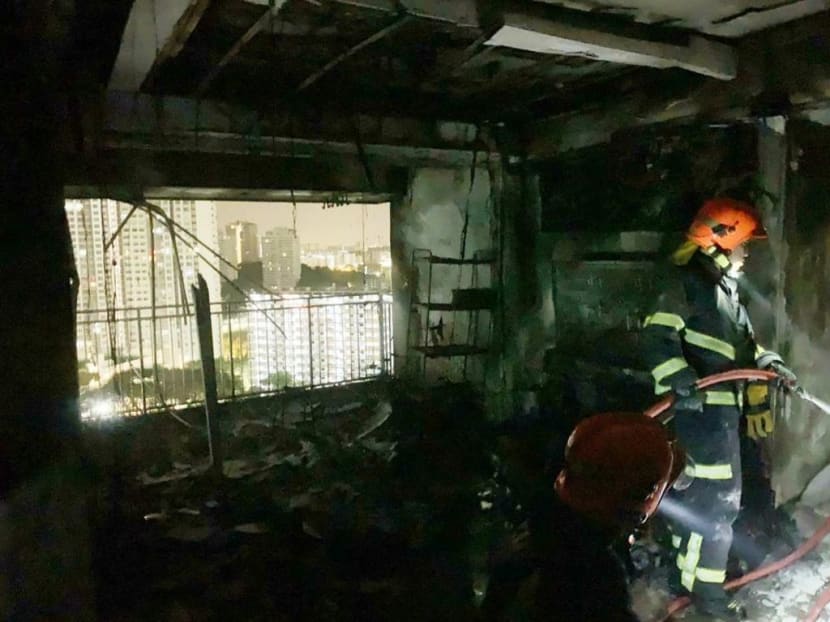SCDF investigating faulty wet risers at The Peak in Toa Payoh following high-rise fire
SINGAPORE — When firefighters rushed to a high-rise unit in Toa Payoh that caught fire on Aug 29, not only did their fire engine face problems entering the estate, the emergency personnel discovered that the block’s wet riser was faulty.

The scene inside a high-rise burnt out unit at The Peak housing estate in Toa Payoh on Aug 29, 2020.
- SCDF may take enforcement action against any parties responsible for wet riser system
- Bishan-Toa Payoh Town Council said the system was working fine when inspected, but will investigate the issue
- SCDF is also working with HDB to put up signs displaying entries and exits for emergency vehicles
SINGAPORE — When firefighters rushed to a high-rise unit in Toa Payoh that caught fire on Aug 29, not only did their fire engine face problems entering the estate, the emergency personnel discovered that the block’s wet riser was faulty.
In a statement on Wednesday (Sept 9), the Singapore Civil Defence Force (SDCF) said it is investigating the cause of the malfunction at The Peak housing estate, adding that it may take enforcement action against any parties responsible.
Last Friday, the SCDF issued a notice to the Bishan-Toa Payoh Town Council. SCDF is also working with the Housing and Development Board (HDB) to place signages which direct emergency vehicles into and out of the estate.
Despite the problems it faced, SCDF had managed to put out the blaze using hose reels with no loss of life. Three people were sent to the hospital and another 300 were evacuated.
An SCDF spokesperson added that neither of the issues compromised the firefighting operation.
“As a general practice, SCDF simultaneously deploys the use of hose reels and water jets in firefighting operations,” SCDF wrote in its statement.
“Hose reels are generally faster to operate but have a lower flow rate, which makes them more suitable for smaller fires and/or incidents which require fast responses. Water jets, which are connected to a wet riser, have a higher flow rate but require more time to set up.”
A spokesperson for the town council said on Wednesday that the wet riser system was working fine when its contractor conducted a joint site inspection with SCDF on Aug 29, the day of the fire, after it was put out.
“The riser was last checked by our fire protection contractor on Aug 26, 2020. The contractor’s report showed that the wet riser system was in order,” the spokesperson added.
The Bishan-Toa Payoh Town Council has engaged a professional engineer to investigate why the wet riser system had no water during the fire and will disclose the findings when the investigations are completed.
As for the fire engine that could not enter the estate, the SCDF said it was because the entrance it used was not meant as the entry point for emergency vehicles.
“The CPL (Combined Platform Ladder) had inadvertently attempted to enter the estate using the designated exit for emergency vehicles, as the 2007 Fire Code did not require signage to indicate the designated entry/exit points,” it wrote.
But the designated exit only allowed for emergency vehicles to leave, as the linkway roof and road divider curbs there did not allow for a sufficient turning radius and clearance for emergency vehicles to enter.
The CPL is a specialised fire engine that helps firefighters conduct rescues and reach fires at high-rise units, an SCDF spokesperson said.
It was one of 11 emergency vehicles that were deployed to fight the fire on the 20th and 21st floor at Block 138C at The Peak, along Lorong 1A Toa Payoh. The other emergency vehicles used the designated entry and reached the incident site without issue, SCDF said.
SCDF is working with HDB to put up designated entry and exit signages for emergency vehicles at other HDB developments besides The Peak, as these estates were not retroactively subjected to the updated 2018 Fire Code that required these signages.
A similar incident occurred in November last year when firefighters faced difficulties accessing hose reels at a block in Bukit Batok when attending a fire that resulted in the tragic death of a 60-year-old woman who succumbed to her injuries. Her husband and their son were also injured.
The Jurong-Clementi Town Council had installed padlocks on the fire hose cabinets to “prevent casual vandalism”. Even after breaking the padlock, firefighters were still unable to use the fire hose reel because there was no water supply.
The Member of Parliament for Bukit Batok, Mr Murali Pillai, apologised for the incident and said the town council was taking disciplinary action against the two officers who directed that the cabinets be locked.
SCDF issued notices directing the town council to fix the non-compliance with fire safety requirements and said then that the town council could be liable for a composition fine or even prosecution if non-compliances of the same nature are detected again.











